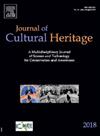Evaluation of the reversibly cross-linked polymer-consolidated waterlogged archaeological woods from Zhangwan No.1 shipwreck
IF 3.3
2区 综合性期刊
0 ARCHAEOLOGY
引用次数: 0
Abstract
Zhangwan No.1 Shipwreck, excavated in 2012, urgently requires the application of conservation materials to protect its waterlogged archaeological woods. In this work, reversibly cross-linked polymer (RCP) is employed as conservation materials to consolidate the waterlogged archaeological woods from Zhangwan No.1 Shipwreck and its corresponding consolidation effect is thoroughly evaluated. RCP-based conservation materials are constructed by penetrating 2-formylphenylboric acid modified polydimethylsiloxane (PPBA) into the waterlogged wood samples, and then in-situ reversibly cross-linking by N-coordinated boroxines (NCBs). In-situ formed reversibly cross-linked conservation materials (PNCB) can support the structure of the archaeological woods to improve their dimensional stability. The shrinkage rate of the PNCB-consolidated archaeological woods is ∼2.1% and its anti-shrinkage efficiency is ∼85.6%. Moreover, the PNCB-consolidated archaeological woods exhibit the excellent humidity stability and thermostability due to the stable cross-linking network of PNCB. Even under the environment with relative humidity of 100%, the equilibrium moisture content (EMC) of the PNCB-consolidated archaeological woods is only ∼0.4%, significantly lower than that of un-consolidated and polyethylene glycol-consolidated archaeological woods. Because the NCB cross-linkers can be broken by ethanol, the PNCB conservation materials within the archaeological woods can be depolymerized into PPBA and eliminated from the archaeological woods after ethanol immersion.

张湾1号沉船考古木材可逆性交联聚合物固结水淹评价
2012年发掘的张湾一号沉船,迫切需要应用保护材料来保护其淹水考古木材。本文采用可逆交联聚合物(RCP)作为保护材料对张湾一号沉船考古淹水木材进行加固,并对其加固效果进行了全面评价。通过将2-甲酰苯基硼酸改性聚二甲基硅氧烷(PPBA)渗透到浸水木材样品中,然后通过n-配位硼氧胺(NCBs)原位可逆交联构建rcp基保护材料。原位形成的可逆交联保护材料(PNCB)可以支撑考古木材的结构,提高其尺寸稳定性。pncb固结考古木材的收缩率为~ 2.1%,抗缩效率为~ 85.6%。此外,由于PNCB稳定的交联网络,PNCB固结考古木材表现出优异的湿稳定性和热稳定性。即使在相对湿度为100%的环境下,pncb固结考古木的平衡含水率(EMC)也仅为~ 0.4%,显著低于未固结和聚乙二醇固结考古木。由于NCB交联剂可以被乙醇破坏,因此考古木材中的PNCB保护材料在乙醇浸泡后可以解聚成PPBA并从考古木材中消除。
本文章由计算机程序翻译,如有差异,请以英文原文为准。
求助全文
约1分钟内获得全文
求助全文
来源期刊

Journal of Cultural Heritage
综合性期刊-材料科学:综合
CiteScore
6.80
自引率
9.70%
发文量
166
审稿时长
52 days
期刊介绍:
The Journal of Cultural Heritage publishes original papers which comprise previously unpublished data and present innovative methods concerning all aspects of science and technology of cultural heritage as well as interpretation and theoretical issues related to preservation.
 求助内容:
求助内容: 应助结果提醒方式:
应助结果提醒方式:


